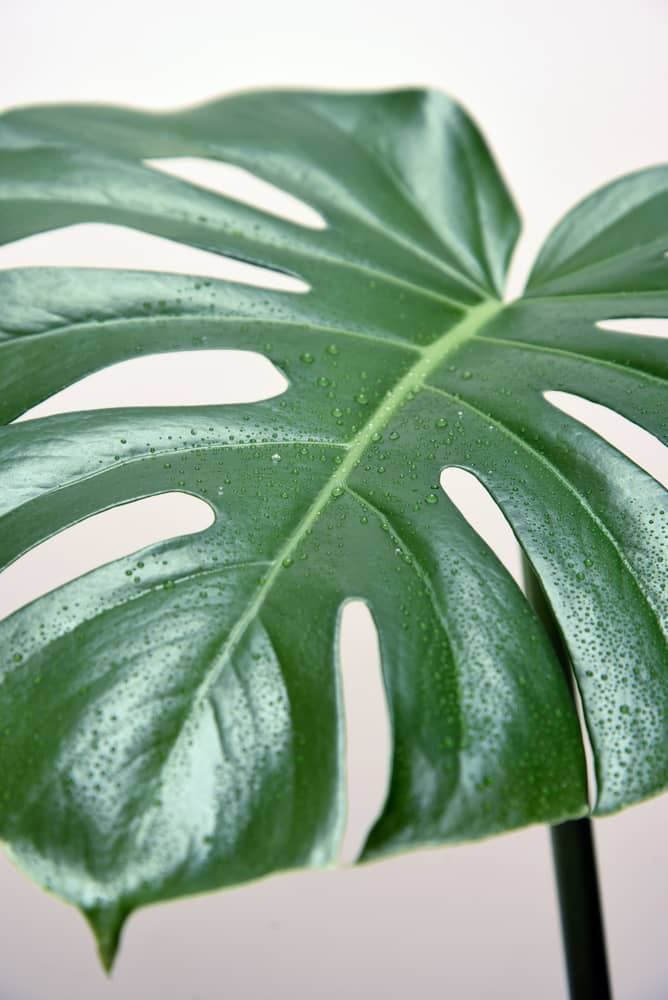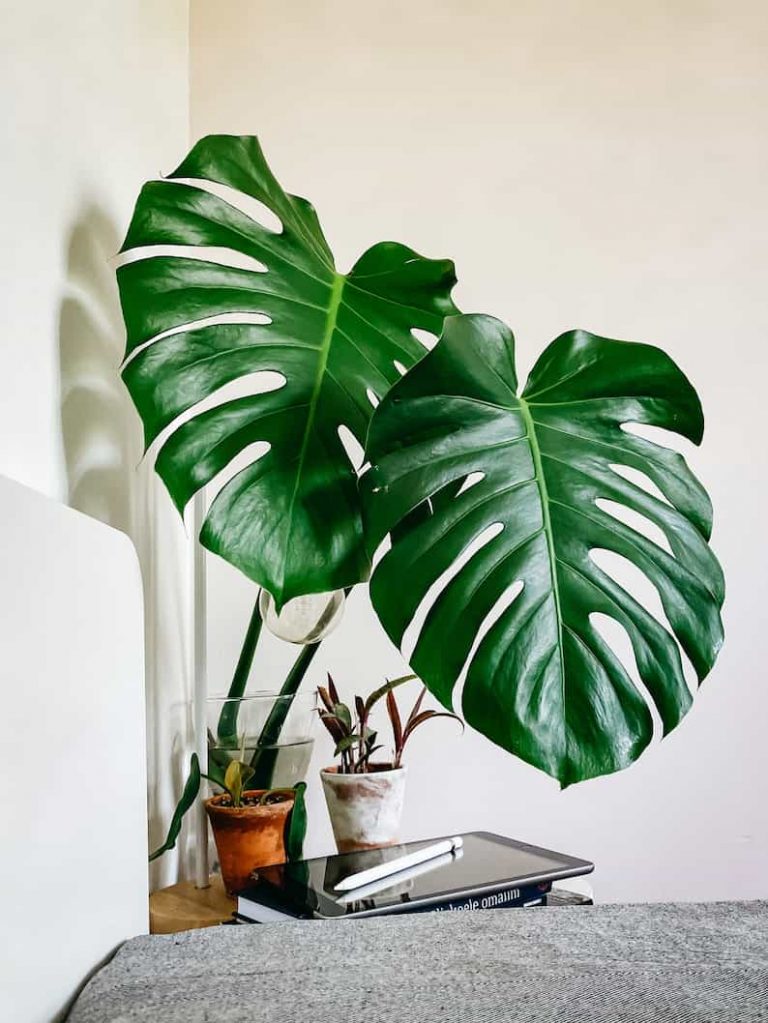Monstera is a genius of tropical plants native to Central America’s rainforests, and some people know the Monstera from its nickname “Swiss Cheese Plant.” Once you see the plant, you will quickly understand how it got this name. The large holes or fenestrations in their attractive foliage is one of the reasons why this plant is so coveted by many gardeners.
In fact, Monstera leaves have taken the world by storm. That deep green foliage with its unique holes has made its way from the houseplant world to home decor, earrings, shirts – there are even Monstera leaf tattoos!
So once you have your own Monstera plant in your home, it’s understandable that your priority is going to be to keep your Monstera leaves healthy so that they can take pride of place in any room. I’ll show you just how to do that, along with some other tidbits on the fact that Monstera leaves have some meaning – besides the fact that they look pretty amazing.

Table of Contents
Why do Monstera leaves have holes?
Monstera leaves have holes to allow for better growth. In their natural rainforest habitat, these holes let sunlight break through the upper leaves to reach the lower leaves, while also allowing for rain to fall through the holes to the roots below the plant.
All of this was developed naturally by the plants so as to adapt to their native environment.
But if you have never grown a Monstera plant before, you may be alarmed to see holes in the leaves. Don’t worry: This plant is supposed to have these holes and splits in its foliage. It is one of the reasons that attracts fellow houseplant lovers to the Monstera.
Keep in mind, however, that when it comes to when Monstera leaves split, you’ll notice that young or baby Monstera leaves won’t have holes or splits in them. As the leaf matures through the various Monstera growth stages, however, those distinct fenestrations will start to form.
How to care for Monstera leaves?
The best way to keep Monstera leaves healthy is to give the plant proper care. Without proper care, the plant won’t be able to produce those large leaves that everyone desires.
1. High levels of humidity
The Monstera loves humidity and needs a 65-percent humidity level or higher. The good news is that you can easily provide the plant with this high level of humidity by either using a humidifier in the same room as the plant or setting the plant on a pebble tray.
2. Right temperature
If you don’t live in USDA Plant Hardiness Zones 9B to 11, you won’t able to let your Monstera live outside all the time. These tropical plants need a constant temperature of between 65 and 80-degrees Fahrenheit.
While the Monstera can survive in temperatures as low as 50-degrees Fahrenheit, it is not recommended to have the plant in these low temps for too long, especially if you wish to keep your Monstera leaves healthy. Doing so will prevent the plant from growing properly and will eventually kill it.

3. Appropriate amount of water
Overwatering and underwatering will have a direct, negative effect on the Monstera leaves. Too much water and the leaves can become water-logged and rotten. Not enough water and the leaves will wrinkle, dry, and fall off the plant.
Regularly check the top 2 inches of the plant’s soil for dryness. Once those top 2 inches start to feel dry, water the plant deeply. If the top 2 inches still feel moist, don’t water just yet and wait a day or two before checking again.
Related: Exactly How Often to Water Your Monstera
4. The correct amount of light
When it comes to Monstera’s light requirements, these plants need indirect, bright light in order to keep Monstera leaves healthy. Too little light and the plant will experience stunted growth, while too much light will cause the Monstera leaves to burn.
A window that faces east is the best indoor location for Monstera plants as it provides them with that indirect bright light they need.
5. Regular feeding of your Monstera
Applying a slow-release fertilizer to the plant during its active growing period is a great way to ensure your plant gets the proper nutrition it needs to keep your Monstera leaves healthy. Choose a fertilizer for your Monstera that is designed for tropical houseplants and apply it once or twice every month.
6. Pruning the Monstera
The Monstera doesn’t need much pruning. Over pruning can actually hurt the growth of the plant. Instead, save the pruning to only remove dead or damaged leaves.
When pruning your Monstera, make sure to always use sharp pruning shears that have been cleaned and sanitized, and never prune more than 1/4 of the plant’s foliage.

7. Deal with pests
Since Monstera plants are most often grown indoors, they don’t have to deal with nearly as many bugs as outdoor plants. That’s not to say that they are immune to pest problems. In fact, spider mites, mealy bugs or even thrips on your Monstera can all be issues, as they can feast on indoor plants and even damage their leaves.
Regularly inspect the Monstera looking for pest problems. If you find any signs of pests on your Monstera, liberally apply insecticidal soap to the entire plant. Make sure to follow the application instructions on the bottle.
How long will a Monstera leaf last?
Once cut off a plant, the Monstera leaves can last for up to three weeks. The reason why the leaves last so long after being removed from the plant is because the Monstera leaves have a slower water evaporation rate than other plants.
This means that if you want to keep your Monstera leaves in a vase, you’ll have several weeks to enjoy this once you prune the leaf from the plant. Of course, any longer than that and you may have to consider either getting a new leaf or consider investing in Monstera leaves that are fake. Fortunately, there are some great artificial Monstera leaves out there (check the latest price of these ones, for example).

You’ll notice young Monstera leaves growing every 4 to 6 weeks. New growth on your Monstera always occurs at the growth point on the plant, and its growth rate will keep increasing as long as the plant keeps having healthy growth.
With proper care, the Monstera plant has the ability to grow up to 15-feet wide and 30-feet tall. Keep in mind, however, that this size was for an outdoor plant, and indoor Monsteras typically don’t reach such large sizes.
What do Monstera leaves represent?
For many cultures, Monstera leaves have some meaning. Some believe that growing the Monstera plant in your home will bring good luck. In other cultures, however, this plant represents respect towards people, longevity, and even honoring your elders.
No matter what you believe, if given the right care, the Monstera can certainly bring joy to your home for years.
Why are people obsessed with Monsteras?
There are many reasons as to why people are obsessed with Monsteras. This includes the plant’s attractive and interesting foliage, as well as its easy-going nature. The leaves of the Monstera plant can add texture and interest to any indoor garden, which is a selling point for sure.
When you add on the fact that these plants are not too hard to care for, you can quickly see why gardeners of all experience want to add the Monstera to their collection.
Especially when compared with other tropical houseplants, the Monstera are relatively easy-to-care for and so are an excellent addition to any home – and as icing on the cake, they look great too thanks to these big, beautiful Monstera leaves!
